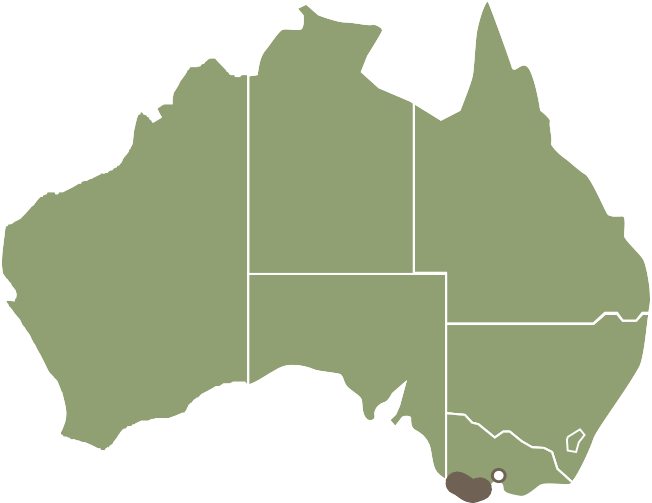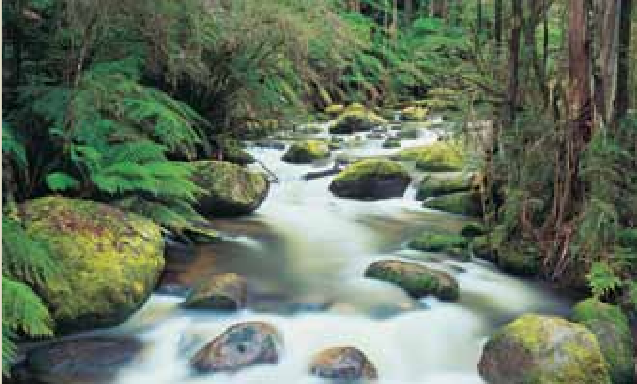The Great Ocean Road
大洋路

The raw energy of the Great Southern Ocean meets a spectacular landscape to create awe inspiring scenery and a vast array of ever changing landscapes, communities, habitats and wildlife that will captivate and invigorate.
GEOLOGY IN REAL TIME
Limestone layers have eroded at different rates to create tunnels and caves as well as spectacular natural structures like the Twelve Apostles and the Loch Ard Gorge. Erosion occurs at a rapid rate as the awesome power of the sea pounds the earth — co Ila psi ng one of the Twelve Apostles in 2005 and tumblingthe London Bridge rock formation into the sea in 1990.
COASTAL LANDSCAPES
The breathtaking cliff faces ofthe Great Ocean Road fall away to a spectacular marine environment. The intertidal zone supports a vast array of crabs, molluscs, fish, seaweed and algae as well as fantastic bird life. Over 170 bird species can be seen throughout the landscape, with the internationally threatened peregrine falcon nesting in the landscape’s protected cliffs and rock stacks. You can often see many other species including albatross, gannets, honeyeaters, cockatoos and eagles. At the base ofthe famous Twelve Apostles rock formation, a colony of around 1,000 little penguins can be seen from special viewing platforms just after the sun goes down. Offshore islands provide a home forthe critically endangered orange-bellied parrot.
A LIVING OCEAN
Beneath the ocean surface lies an explosion of life — 85 per cent of species found in the waters here are found nowhere else on earth. Deep sea and reef fish, sharks, dolphins, octopus, sea dragons and the Australian fur seal all inhabit the area. Offshore reefs 30 to 60 metres underwater are home to brilliant sponge gardens and kelp forests where fish and other aquatic species such as sea dragons, sea slugs and sea stars make their homes. The diversity and abundance of marine wildlife has significantly increased since the introduction of a marine reserve system in 2002. From June to September, the magnificent southern right whales come to the sheltered, nutrient-rich waters around Warrnambool to breed before making their way up the east coast of Australia. Mothers and calves have often been found as close as 100 metres from the shore.
WEEDY SEA DRAGON
The leafy-looking fins of the 46 centimetre weedy sea dragon provide excellent camouflage as they swim amongst seaweed.They are one ofthe only creatures in the world where the male cares for the eggs and carries them on histail duringthetwo-month gestation period.The weedy sea dragon is Victoria’s marine emblem.
HEATHLANDS
The spectacular variety of plants in the 7,500 hectare Anglesea heathlands burst into life during springto create an amazing wildflower display. More than 700 plant species have been recorded in the area, including 162 species in one hectare alone — the highest diversity of flora anywhere in Victoria. The 79 species of orchid found here makes it one of the most orchid-rich sites in Australia.
HINTERLANDS
Inland from the coastal landscape lies the cool, wet hinterland rainforests. Home to a variety of kangaroos, wallabies, possums, bandicoots, echidnas and bats, the Great Otway National Park is a landscape oftall eucalypts and mysterious beech forests, rushing waterfalls, cascading streams and secret pockets of fern gullies.
THE GREAT OCEAN WALK
The 104 kilometre Great Ocean Walk provides an opportunity to experience a range of natural environments — tall forests, deserted beaches and remote cliff-tops. The walk’s 'step-on, step-off’approach means visitors can choose to walk the whole, or parts ofthe route, with options to pitch a tent or stay in luxury accommodation. For more information gotowww.greatoceanwalk.com.au.
ROAD INTO HISTORY
The Great Ocean Road was part of a major plan to create employment for soldiers returning from the First World War. Fourteen years in construction, the Great Ocean Road is today recognised as a massive feat in engineering and planning and has been listed on Australia’s National Heritage list. Around 700 ships are believed to have been wrecked along the Victorian coast, but less than athird ofthem have been discovered.The ancient shipwrecks, which can be found along the coast line, tell dramatic tales oftragedy and survival of Australia’s early European settlers trying to start a new life.
HELP PROTECT THIS SPECIAL COASTAL ENVIRONMENT
You can make your own contribution to conserving our natural world when you visit the Great Ocean Road. Keep our marine environment clean — plastics and other rubbish can pollute our oceans and have severe effects on marine species. When fishing or walking, take your rubbish with you. You can take a hands-on approach to conservation activities on the Great Ocean Road by:
• Reporting a whale sighting -take part in a community project to record whale sightings alongthe coast. For more information go to: http://visitgreatoceanroad. org.au/whale-sightings
• Get hands on in the hinterlands - visit www.gorcc.com.au to find out more about the wide range of environmental coastal volunteer groups that operate in the region.
• Taking a walk on the wild side - taking part in a Conservation Volunteers Australia program to collect native seeds and undertake weeding, document wildlife through photography or help rehabilitate frog breeding sites, www.conservationvolunteers.com.au
For more information on this landscape orto learn about other naturally beautiful places which offer a different but uniquely Australian experience. Visit www.australia.com/nl
大洋路
南大洋的原始力量与壮观的环境相得益彰。风景优美,变化莫测的景观区、生物群落,栖息地和野生动植物引人向往且生机勃勃。
触手可及的地质学景观
大洋路的石灰岩层由于不同程度的侵蚀,形成了隧道、洞穴以及壮观的自然结构,如十二门徒岩和洛克阿德峡谷。由于海洋对地面的巨大冲击力,岩石的侵蚀加剧——2005年十二门徒岩中的一块坍塌,而伦敦桥岩层其中的一个桥拱在1990年就翻滚入海了。
海岸风景优美
大洋路的悬崖峭壁坐落在壮观的海洋环境之中。潮间带区域生活着大量的螃蟹、软体动物、鱼类、海草和海藻,还有美丽的鸟类。 在这处美景中可以看到170多种鸟类,世界濒危鸟类游隼就在此地受保护的悬崖和岩石堆栈中筑巢。观光者们还可以看到许多其他物种鸟类的身影,比如信天翁,塘鹅,吸蜜鸟,凤头鹦鹉和鹰。 每当夕阳西下,约1000只小企鹅聚集在著名的十二门徒岩底部,游客可从一个特殊观景平台观看。离岸岛屿也为高度濒危的橙腹鹦鹉提供了栖息地。
生机勃勃的海洋世界
海面下的世界热闹非凡——这里水域中85%的物种都是当地独有的。 深海鱼、珊瑚礁鱼、鲨鱼、海豚、章鱼、海龙和澳大利亚海豹都栖息在这片海域。水下30至60米深的近海珊瑚礁是美妙的海绵花园和海带森林的栖息地,也是鱼类和其他水生物种,如海龙、海蛞蝓和海星的家园。自2002年引入海洋保护区系统以来,海洋野生动物的多样性和数量都显著提升。 每年6月到9月,庞大的南露脊鲸会来到瓦南布尔周围的水域。这片水域有遮蔽,并且富含营养,南露脊鲸来到此处繁殖之后会继续前往澳大利亚东海岸。母鲸和幼仔经常会出现在距海岸100米处。
草海龙
草海龙身长46厘米,叶状鱼鳍为其在海藻中的游动提供了极好的伪装。雄性草海龙负责孵卵,这样分工的物种在世界上并不多见。在两个月的孕育期间,雄性草海龙会将卵携带在尾巴上。维多利亚州海洋徽章上的象征物即为草海龙。
野地
占地7500公顷的安格尔西野地上,植物种类繁多,在春季焕发出勃勃生机,野花烂漫。据记录,该地区有700多种植物物种,其中有些区域,一公顷范围内就有162种植物,这也是维多利亚州植物群最丰富的地方。此处共有79种兰花品种,也是澳大利亚兰花最丰富的地区之一。
腹地
沿海景观的内陆地块是凉爽湿润的腹地雨林。大奥特韦国家公园是各种袋鼠、沙鼠、负鼠,袋狸,针鼹和蝙蝠的家园。在公园内有高大的桉树林、神秘的山毛榉森林、湍急的瀑布,层叠的溪流和隐秘的蕨类沟壑。
大洋路步道
大洋路步道长达104公里,给游客们提供了体验各种自然环境的机会——沿途可见参天的森林,荒凉的海滩和遥远的悬崖。步道旅行具备“即刻参与,随时休息”的优势,游客可以选择全路线步行,或部分路线步行,可以搭帐篷休息,也可选择住豪华酒店。



